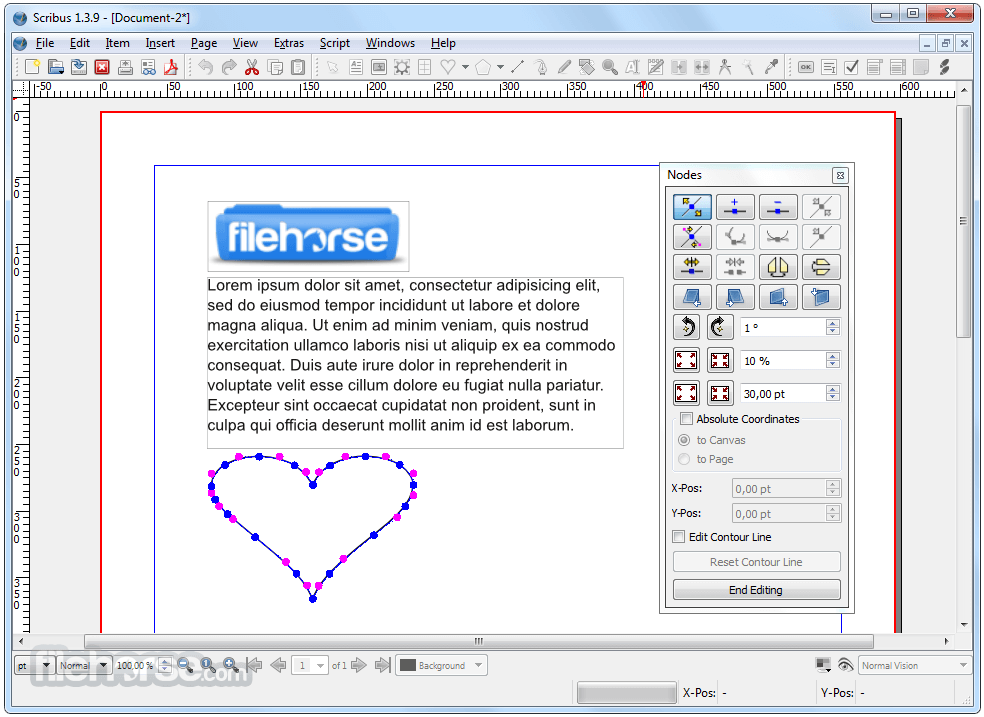

Pantone colors can be obtained and incorporated within Scribus without licensing issues. ĭue to licensing issues, the software package does not include support for the Pantone color matching system (PMS), which is included in some commercial DTP applications.

Scribus cannot read or write the native file formats of other DTP programs such as QuarkXPress or InDesign the developers consider that reverse engineering those file formats would be prohibitively complex and could risk legal action from the makers of those programs. Scribus 1.4.7 did not have OpenType alternative glyph support, so ligatures, for example, were not inserted automatically this became available from v1.5.3. In December 2016 Scribus announced they got support for OpenType advanced feature in 1.5.3svn, as well as complex script and RTL direction. In July 2016 it was announced that the text layout engine had been rewritten from scratch in preparation for support of complex scripts coming in Scribus 1.5.3 and later. In May 2015 it was announced that the ScribusCTL project had started to improve complex layout by integrating the OpenType text-shaping engine HarfBuzz into the official Scribus 1.5.1svn branch. In August 2012, it was announced that a third party had developed a system to support complex Indic scripts. Initially, Scribus did not properly support complex script rendering and so could not be used with Unicode text for languages written in Arabic, Hebrew, Indic, and South East Asian writing systems, even though it supported Unicode character encoding. Forthcoming Scribus 1.6 (by way of Scribus 1.5 development branch) ScribusGenerator is a mail merge-like extension to Scribus. Word and PDB documents are only imported as plain text. HTML tags which modify text, such as bold and italic, are supported. ODT files can typically be imported along with their paragraph styles, which are then created in Scribus. Text can be imported from OpenDocument (ODT) text documents (such as from LibreOffice Writer), XML ( Writer's SXW files), Microsoft Word's DOC, PDB, and HTML formats (although some limitations apply). The current file format, called SLA, is XML. PDF support includes transparency, encryption, and a large set of the PDF 1.5 specification including layers (OCG), as well as PDF/X-3, including interactive PDFs form fields, annotations, and bookmarks. The internal driver supports full Level 2 PostScript constructs and a large subset of Level 3 constructs. High-level printing is achieved using its own internal level 3 PostScript driver, including support for font embedding and sub-setting with TrueType, Type 1, and OpenType fonts. It has a built-in scripting engine using Python. Professional type/image-setting features include CMYK colors and ICC color management. The long list of supported formats includes Encapsulated PostScript, SVG, Adobe Illustrator, and Xfig.

Vector drawings can be imported or directly opened for editing. Scribus supports most major bitmap formats, including TIFF, JPEG, and PSD. 2.1 Forthcoming Scribus 1.6 (by way of Scribus 1.5 development branch).2 Support for other programs and formats.1.1 Forthcoming Scribus 1.6 (by way of Scribus 1.5 development branch).There are native versions available for Unix, Linux, BSD, macOS, Haiku, Microsoft Windows, OS/2 (including ArcaOS and eComStation) operating systems. Scribus is written in Qt and released under the GNU General Public License. The Scribus 1.4 series are the current stable releases, and the 1.5 series where developments are made available in preparation for the next stable release series, version 1.6. Example uses include writing newspapers, brochures, newsletters, posters, and books. Scribus can also create animated and interactive PDF presentations and forms. It is designed for layout, typesetting, and preparation of files for professional-quality image-setting equipment. Scribus ( / ˈ s k r aɪ b ə s/) is free and open-source desktop publishing (DTP) software available for most desktop operating systems. GNU LGPL 2.1, MIT, 3-clause BSD, Public domain


 0 kommentar(er)
0 kommentar(er)
